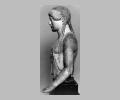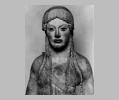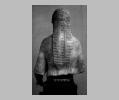
Euthydikos Kore, upper fragment, right profile, detail

Euthydikos Kore, upper fragment, left profile, detail

Euthydikos Kore, upper fragment, left profile

Euthydikos Kore, upper fragment, from right

Euthydikos Kore, upper fragment, frontal view, detail

Euthydikos Kore, upper fragment, back view
| Collection: | Athens, Acropolis Museum |
| Title: | Euthydikos Kore |
| Context: | From Athens, Acropolis |
| Findspot: | Found at Athens, Acropolis, found east of Parthenon in 1882. (Akr. 609 was found near Erechtheion in 1886 or 1887). |
| Summary: | Statue of maiden |
| Object Function: | Votive |
| Material: | Marble |
| Sculpture Type: | Free-standing statue: kore |
| Category: | Single sculpture |
| Style: | Late Archaic |
| Technique: | In-the-round |
| Original or Copy: | Original |
| Date: | ca. 490 BC - ca. 480 BC |
| Dimensions: | Akr. 686: H. 0.589 m; Akr. 609: H. 0.41 m |
| Scale: | Under life-size |
| Region: | Attica |
| Period: | Late Archaic |
Subject Description: Dedicatory statue of maiden, late example of kore type. Frontal pose, characteristic archaic gesture of skirt pulled to side, here with left hand. Left leg forward. Right arm originally extended in offering. Coiffure relatively simple with emphatic central part, three long tresses fall forward over each shoulder. Ionic style of dress with himation over thin chiton, but again simply rendered. Detailed decoration added in paint, as the frieze of racing chariots on the chiton.
Form & Style: Stance and mannerism of skirt pulled hard against legs are characteristically archaic, but concern with underlying structure rather than surface pattern pushes statue into period of Early Classical development. Often compared with Blond Boy (
Date Description: Generally considered to be part of the debris from the Persian destruction of 480.
Condition: Fragmentary
Condition Description: Broken in large fragments with few chips as from single fall, but where preserved surface is fresh and shows little wear. This fragment preserves upper body including head and most of left arm, broken at waist. Another fragment,
Material Description: Possibly Parian marble
Inscription: On the base, a column capital, in stoichedon:
Sources Used: